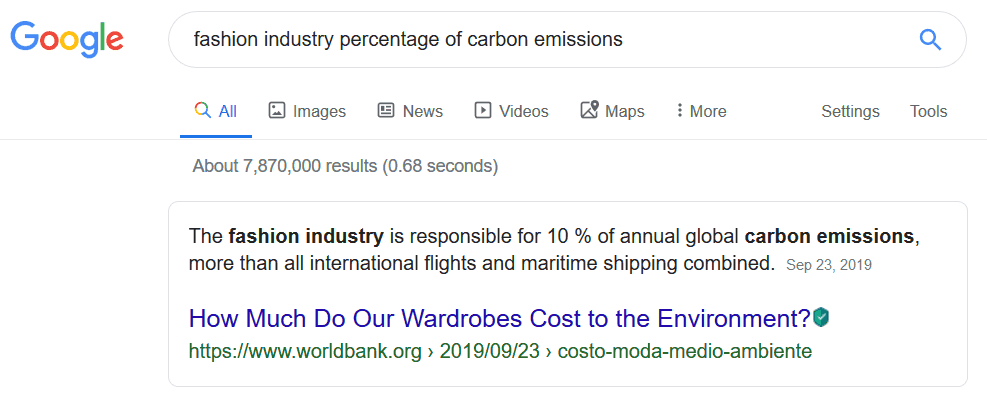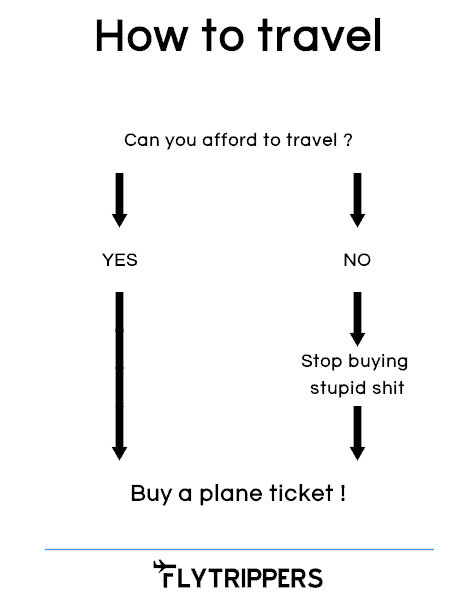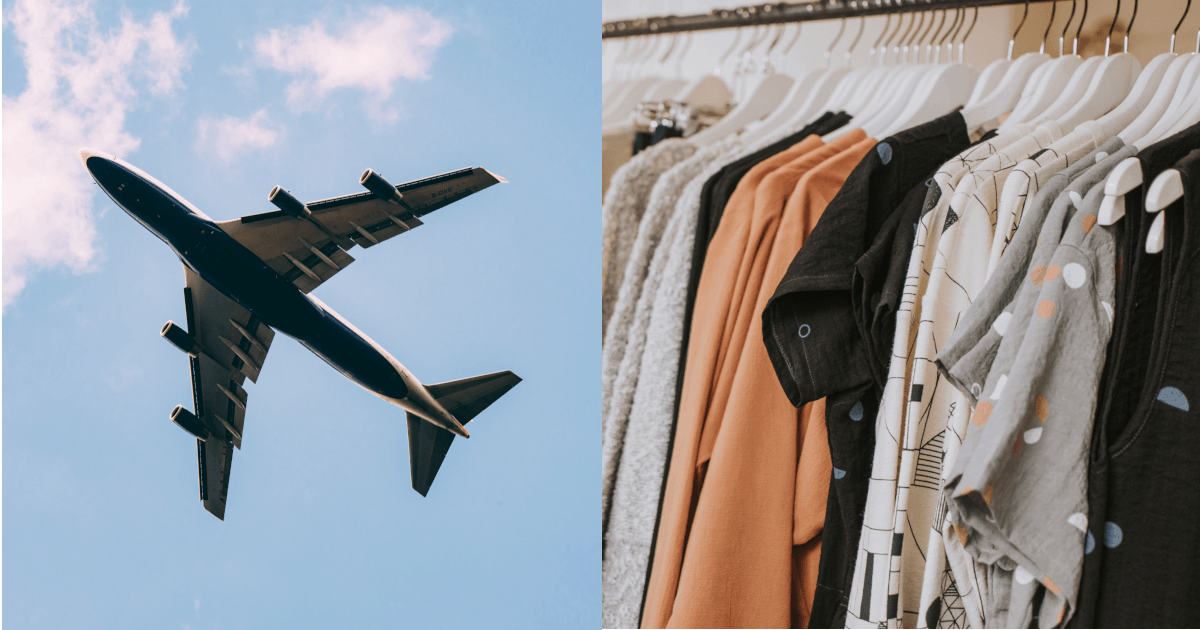Here is the answer: the fashion industry. And it’s not even close either. Air travel gets such a bad rap, even though for many of us, travel is a life-changing experience that allows us to grow as humans and connect with other cultures… but the aviation industry actually pollutes a lot less than all the useless new clothes people buy all the time.
Just to be clear: I’m not saying air travel is great for the environment. It’s obviously not (we’ll have an article soon about the best ways to make traveling greener—sign up today for free to make sure you don’t miss it).
I’m saying we need to keep things in perspective. The UN reports that the fashion industry produces more carbon emissions than all international flights and all maritime shipping combined.

 I’ll share shocking stats below, but yes, air travel is a lot less damaging to the environment than the clothing industry, which is surprising to many. And many people who buy clothes they don’t even need that don’t bring any value to their life, while travel definitely sparks joy in our lives.
I’ll share shocking stats below, but yes, air travel is a lot less damaging to the environment than the clothing industry, which is surprising to many. And many people who buy clothes they don’t even need that don’t bring any value to their life, while travel definitely sparks joy in our lives.
(Let me remind you that it’s scientifically proven that material possessions don’t make humans anywhere near as happy as experiences do. And in terms of great life experiences, travel is hard to beat.)
Why It’s Okay To Travel
Basically, let’s not “fly-shame” everyone who travels or focus on that alone. The point is, there are other ways to have an impact that don’t require sacrificing something as positive for your wellbeing as travel.
We should take a look at other even easier ways to be greener. Like not buying so many clothes.
Nobody really cares what you wear (and those who do are probably the type of people whose opinion you really shouldn’t value in life).
More clothing clutters your life (Marie Kondo, anyone?).
More travel makes you a better human.
I’m not even saying everyone should stop buying new clothes. I’m all for freedom of choice for consumers, always (especially the choice of paying less for flights thanks to a-la-carte pricing).
If you want to buy tons of new clothes, buy tons of new clothes. Some like that, and good for them! I feel like that’s a complete waste of money, but that’s just my personal opinion: everyone should be able to do as they please.
But if we’re not going to “clothes-shame” everyone who buys their useless new clothing items, we shouldn’t “fly-shame” everyone who flies and travels. Because for many people, traveling is what they value the most, even though it seems dumb to other people… just like buying new clothes every month seems dumb to me.
Does everyone feel bad every time they buy clothes? No. Nor should they.
So don’t feel bad about traveling.
Explore the world, experience new things and connect with locals. Gain a better understanding of other cultures, become more open-minded. Get out of your comfort zone and grow as a person.
And, maybe, try buying fewer clothing items. Giving up buying as many clothes is way easier than giving up traveling.
Not only will it help the environment, but it will also help you with your travel budget by saving money for memorable experiences instead of textiles that you’ll throw away and literally never remember when you look back on your life.
You will remember the travel memories.
A Common Bias
“Flight-shaming” is another one of the many irrational responses (not based on facts), like how people think that traveling to X country is dangerous, so they don’t go. But statistically, factually… driving to the movie theater near their home is many times more likely to kill them due to the danger of car accidents, but no one ever worries about that.
It’s a very common bias: something that is done almost daily so we don’t focus on it, compared to something that is done less often and therefore seems worse.
It’s still safer to travel to almost every country than it is to just drive in our own. And the fashion industry is still worse for the environment than the aviation industry.
But since it’s routine and we’re desensitized to it, we don’t see it rationally. It’s easier to blame something we do just a few times a year than it is to make an actual effort to have to fundamentally change how we live. Everyone has great intentions these days, but the fact remains that actions are what matter.
It’s just as “non-essential” to go to the movie theater (there are other types of entertainment that don’t require driving, and therefore aren’t as dangerous) as it is “non-essential” to travel to “dangerous” countries.
It’s even more “non-essential” to buy new clothes every month as it is “non-essential” to travel and broaden your horizons.
My point is, if we want to encourage greener behaviors, like anything, we should focus on the biggest culprits first. Prioritize the things with the most impact.
The fashion industry generates 4 times more carbon emissions than the air travel industry and doesn’t bring much value to everyone’s life. Compared to travel, which is an amazing experience for everyone.
Not to mention the terrible working conditions of people who make most of our clothing. Some will argue that without it, those people would be even worse off. And maybe that’s the case, but that’s a whole other topic.
On the other hand, traveling and spending our money in these countries, boosting their local economy, and raising their standards of living are definitely other positive aspects of traveling that have a great impact on those who need it most.
Fashion Industry Stats
So here are a few stats to think about.
Total greenhouse gas emissions:
- Fashion industry: 10% of humanity’s carbon emissions
- Aviation industry: 2.5% of humanity’s carbon emissions
And keep in mind that business travel represents the majority of air travel. Most of you who follow Flytrippers travel for leisure, not business. So your own 3–4 trips a year are by no means good for the environment (my own very excessive flying certainly isn’t)… but you’d be surprised when you compare it with the clothing industry.
According to the United Nations Environment Programme (UNEP), the equivalent of one garbage truck full of clothes is burned or dumped in a landfill every second.
On average, Americans buy 68 new pieces of clothing every year. Yes, 68.
In the 1980s, that number was only 12 (that is a 450% increase if you’re keeping track).
Just since 2000, the average consumer buys 60% more clothing, but keeps each garment for half as long.
Here’s another shocking stat: 50% of clothing items will be thrown away after being worn less than 3 times.
Up to 85% of textiles go into landfills each year. Even the clothes that are donated are often thrown away and incinerated: one Salvation Army location in NYC alone throws away 18 tons of clothes every 3 days.
Clothing production has, in fact, increased by 100% (doubled) just since 2000.
One cotton shirt requires 2,700 liters of water to produce—enough drinking water for one person for 3 years.
One pair of jeans? 7,500 liters—enough drinking water for one person for 10 years.
One jacket? 10,300 liters—enough drinking water for one person for 14 years.
Producing synthetic fabrics like polyester, spandex and nylon used about 350 million barrels of oil last year.
That doesn’t even include the carbon emissions to ship clothes from (mostly) Asia to all over the world.
In short, buying new clothes is horrible for the environment.
What should you do to reduce the environmental impact of your clothing choices? Well, it’s not rocket science: buy fewer clothes or at the very least just wear them longer.
But we’re not fashion experts or environmental experts; we’re travel experts. We want you to experience the positive impact of travel.
And, yes, we should all still be careful and follow the tips to make traveling greener that we’ll soon share (Have some of your own? Share them with us in the comments and we might include them!).
By the way, the most polluting part about air travel comes from the aircraft’s total weight, which is increased by… the useless clothing most people insist on overpacking. So again, traveling light is not only cheaper and more fun, it’s better for the environment too.
Bottom line it’s okay to travel—it’s such a positive experience.
And you can do more of it if you wish to:

Want to learn to travel greener with all our great tips?
Summary
Flying is by no means good for the environment, but it’s good to keep things in perspective: there are other ways to reduce your impact, like buying less clothing. Travel has so many positive impacts for you as a human being, we recommend you do more of it. Don’t miss our upcoming tips on how to travel more sustainably if you are interested.
You can also read our previous quizzes:
- – 40° F or – 40° C: Which One Is Colder?
- Canada or USA: Which Country Is Bigger In Land Area (Excluding Water)
- Spain or Brazil: Which Country Does France Share Its Longest Border With?
- Montreal or Manhattan: Which Island Has More Inhabitants?
Are you surprised by the fashion industry’s environmental impact? Have any green travel tips to share with your fellow travelers? Let us know in the comments below!
Want to see our current discounted plane tickets?
Click here to see our flight deals
Want more travel tips and inspiration?
Click here to see the blog homepage
You’ll probably enjoy this article:
Travel Hacking: Free Travel (really)
Help us spread the word about our flight deals and travel tips by sharing this article and, most importantly, bookmark Flytrippers so we can help you navigate the world of low-cost travel!
Featured image: flying airplane and clothing rack (Photo Credit: Unsplash)
Advertiser Disclosure: Flytrippers receives a commission on links featured in this blog post. We appreciate it if you use them, especially given it never costs you anything more to do so, and we thank you for supporting the site and making it possible for us to keep finding the best travel deals and content for you. In the interest of transparency, know that we will NEVER recommend a product or service we do not believe in or that we do not use ourselves, as our reputation and credibility is worth far more than any commission. This principle is an essential and non-negotiable part of all our partnerships: we will never give any third-party any control whatsoever on our content. For more information on our advertiser disclosure, click here.




